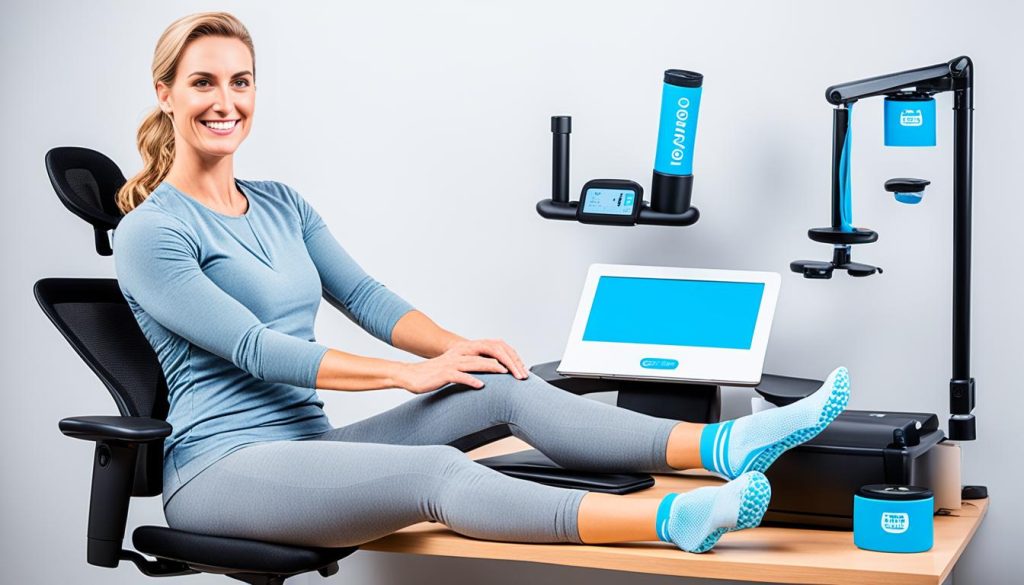I’m sure many of us have experienced the discomfort of swollen ankles while sitting at our desks for long hours. It can be frustrating and distracting, but understanding why it happens is the first step towards finding relief. In this article, we’ll explore the reasons behind desk-related ankle swelling and discuss some tips to reduce and prevent it.
Why Do My Ankles Swell When I Sit at My Desk
- Painless swelling of the feet and ankles, known as edema, is a common issue, especially among older individuals.
- Ankle swelling at the desk can be caused by various factors, including being overweight, having a leg infection, or having veins in the legs that cannot properly pump blood back to the heart.
- Risk factors for ankle swelling at the desk include being older, having a blood clot in the leg, or undergoing leg, ankle, or foot surgery.
- There are several tips to reduce ankle swelling at the desk, such as elevating the legs, exercising regularly, following a low-salt diet, and wearing support stockings.
- If ankle swelling is accompanied by shortness of breath, chest pain, or other concerning symptoms, it’s important to seek immediate medical attention.
Risk Factors and Causes of Ankle Swelling
When it comes to ankle swelling at the desk, there are several risk factors and causes to be aware of. These factors can contribute to the discomfort and swelling that many individuals experience while sitting for long periods of time.
- Being overweight: Carrying excess weight puts additional pressure on the legs and feet, leading to fluid retention and swelling.
- Hormonal changes: Hormonal fluctuations, especially during pregnancy or menopause, can cause fluid retention and ankle swelling.
- Injury or surgery: Previous injuries or surgeries involving the leg, ankle, or foot can disrupt the normal circulation and lymphatic drainage, resulting in swelling.
- Long periods of sitting or standing: Immobility for extended periods can impede blood flow and lymphatic drainage, leading to fluid buildup and ankle swelling.
- Certain medications: Some medications, including antidepressants and blood pressure medicines, may have side effects that include ankle swelling.
- Medical conditions: Underlying medical conditions such as heart failure, kidney failure, liver failure, or leg infections can cause fluid retention and contribute to ankle swelling.


Understanding these risk factors and causes is crucial for addressing and preventing ankle swelling while sitting at a desk. By identifying the underlying factors contributing to the swelling, individuals can take steps to alleviate discomfort and improve their overall well-being.
Tips to Reduce Ankle Swelling at the Desk
Are you tired of dealing with ankle swelling while sitting at your desk? Here are some useful tips to help reduce and relieve ankle swelling at the desk.
- Elevate your legs: While lying down, put your legs on pillows to raise them above the heart. This position helps reduce fluid buildup and promotes better circulation.
- Exercise your legs: Regular exercise of the legs, such as stretching, walking, or flexing your feet, can help pump fluid from the legs back to the heart. Take short breaks throughout the day to perform these exercises.
- Follow a low-salt diet: Excessive sodium intake can lead to fluid buildup and swelling. Cutting back on salt in your diet can help reduce ankle swelling. Opt for fresh and natural foods, and avoid processed and packaged meals.
- Wear support stockings: Compression stockings provide gentle pressure on the legs, which helps with fluid circulation and reduces ankle swelling. Wear them during the day, especially if you sit for long periods of time.
- Take breaks and move around: Sitting or standing in one position for too long can contribute to ankle swelling. Make it a habit to take short breaks to stretch, walk around, or perform simple leg exercises. This helps prevent prolonged swelling and promotes better blood flow.
- Avoid tight clothing: Clothing that constricts the thighs, such as tight pants or garters, can impede blood circulation and contribute to ankle swelling. Opt for loose and comfortable clothing that allows for proper circulation.
- Maintain a healthy weight: Excess weight puts pressure on the legs and can contribute to ankle swelling. Maintain a healthy weight through a balanced diet and regular exercise to reduce the strain on your legs.
It’s important to consult with a healthcare provider before making any significant changes, especially if you’re currently taking medications that may be causing ankle swelling. They can provide personalized advice and guidance based on your specific situation.
By incorporating these tips into your daily routine, you can effectively reduce ankle swelling and experience more comfort while sitting at your desk. Remember, taking proactive measures is the key to preventing and addressing ankle swelling at the desk.


When to Seek Medical Attention for Ankle Swelling
While occasional ankle swelling at the desk may be normal, there are certain situations where it’s important to seek medical attention. If ankle swelling is accompanied by shortness of breath, chest pain, or a feeling of pressure or tightness in the chest, it may be a sign of a serious condition and immediate medical attention should be sought. Individuals with pre-existing heart disease or kidney disease should contact their healthcare provider if ankle swelling worsens. Swelling accompanied by redness or warmth in the foot or leg, fever, or new or worsened swelling in only one leg should also be evaluated by a healthcare provider. It’s important to take ankle swelling seriously and seek medical attention when necessary.
While there are various ways to prevent ankle swelling from sitting, such as elevating the legs, exercising regularly, and following a low-salt diet, there may be times when medical attention is necessary.
When to Seek Immediate Medical Attention:
- Shortness of breath, chest pain, or feeling of pressure in the chest
- Worsening ankle swelling in individuals with pre-existing heart or kidney disease
- Ankle swelling accompanied by redness or warmth in the foot or leg
- Ankle swelling accompanied by fever
- New or worsened swelling in only one leg
If you experience any of these symptoms, it’s important to consult a healthcare provider as soon as possible to determine the underlying cause and receive appropriate treatment. Ankle swelling can be a sign of a serious condition that requires medical attention.
Remember, taking care of yourself and seeking medical advice when necessary is key to maintaining your health and well-being. Don’t hesitate to consult a healthcare professional if you have concerns about ankle swelling while sitting at your desk.
Diagnosing and Treating Ankle Swelling at the Desk
When seeking medical attention for ankle swelling at the desk, a healthcare provider will take a medical history, conduct a physical examination, and may order diagnostic tests such as blood tests, x-rays, ultrasound examinations, or an electrocardiogram. Treatment for ankle swelling will depend on the underlying cause and may involve lifestyle modifications such as elevating the legs, exercising regularly, following a low-salt diet, and wearing support stockings. In some cases, medications such as diuretics may be prescribed to reduce fluid buildup. Surgical treatments may be necessary for certain conditions such as venous insufficiency. It’s important to work with a healthcare provider to determine the most appropriate treatment plan for ankle swelling at the desk.
- Medical history and physical examination: A healthcare provider will ask about the symptoms, duration, and any previous medical conditions or injuries. They will also perform a physical examination to assess the swelling and check for any underlying issues.
- Diagnostic tests: Blood tests may be conducted to check for any abnormalities that could be causing ankle swelling. X-rays or ultrasound examinations may be ordered to evaluate the bones, joints, and blood flow in the legs. An electrocardiogram may be performed to assess heart function.
- Lifestyle modifications: Elevating the legs above the heart level while lying down can help reduce fluid buildup. Regular exercise, especially of the legs, can promote better circulation and fluid drainage. Following a low-salt diet can help prevent fluid retention and reduce ankle swelling. Wearing support stockings can provide compression and help with fluid circulation.
- Medications: In some cases, medications such as diuretics may be prescribed to increase urine output and reduce fluid buildup in the body. It’s important to consult a healthcare provider before starting or stopping any medications.
- Surgical treatments: For certain conditions such as venous insufficiency, surgical interventions may be necessary. These procedures aim to improve blood flow and reduce swelling in the legs.
Working closely with a healthcare provider is crucial in diagnosing and treating ankle swelling at the desk. They will provide the necessary guidance and personalized treatment plan to alleviate symptoms and prevent further discomfort. Remember to communicate any concerns or changes in symptoms with your healthcare provider for optimal care.
Conclusion
Ankle swelling at the desk is a common issue that many individuals face, especially those who spend prolonged periods sitting. Understanding the causes and risk factors associated with desk-related ankle swelling is crucial in order to prevent and manage this condition effectively. By implementing simple lifestyle changes, such as elevating the legs, regular exercise, following a low-salt diet, and wearing support stockings, you can significantly reduce ankle swelling.
It’s important to remember that seeking medical attention when necessary is key to managing desk-related ankle swelling. Consulting with a healthcare provider will enable you to receive appropriate treatment and develop a personalized plan to address your specific needs. This collaboration ensures that you proactively manage your ankle swelling and improve overall well-being while working at your desk.
By taking these proactive measures, you can find relief from desk-related ankle swelling and prevent potential discomfort. Prioritizing ankle health is vital to maintaining optimal productivity and comfort throughout your workday. Remember to implement the tips mentioned in this article, work closely with your healthcare provider, and prioritize your well-being while sitting at your desk.
FAQ
Why do my ankles swell when I sit at my desk?
Ankle swelling when sitting at a desk can be caused by various factors such as being overweight, having a blood clot in the leg, having a leg infection, or having veins in the legs that cannot properly pump blood back to the heart. Other causes may include long periods of sitting or standing, certain medications, hormonal changes, and medical conditions like heart, kidney, or liver failure.
What are the risk factors and causes of ankle swelling at the desk?
Risk factors for ankle swelling at the desk include being overweight, having a blood clot in the leg, being older, having a leg infection, or having veins in the legs that cannot properly pump blood back to the heart. Injury or surgery involving the leg, ankle, or foot can also cause swelling. Other causes include long periods of sitting or standing, certain medications, hormonal changes, and medical conditions like heart, kidney, or liver failure.
How can I reduce ankle swelling at the desk?
To reduce ankle swelling at the desk, you can try elevating your legs by putting them on pillows to raise them above the heart while lying down. Regular leg exercises can also help pump fluid from the legs back to the heart. Following a low-salt diet can reduce fluid buildup and swelling. Wearing support stockings can provide compression and help with fluid circulation. Taking breaks and moving around frequently while sitting at a desk can prevent prolonged swelling. Avoiding tight clothing or garters around the thighs and maintaining a healthy weight are also important.
When should I seek medical attention for ankle swelling?
It’s important to seek medical attention for ankle swelling at the desk if it is accompanied by shortness of breath, chest pain, or a feeling of pressure or tightness in the chest, as it may be a sign of a serious condition. Individuals with pre-existing heart or kidney disease should contact their healthcare provider if ankle swelling worsens. Swelling accompanied by redness or warmth in the foot or leg, fever, or new or worsened swelling in only one leg should also be evaluated by a healthcare provider.
How is ankle swelling at the desk diagnosed and treated?
When seeking medical attention for ankle swelling at the desk, a healthcare provider will take a medical history, conduct a physical examination, and may order diagnostic tests such as blood tests, x-rays, ultrasound examinations, or an electrocardiogram. Treatment for ankle swelling will depend on the underlying cause and may involve lifestyle modifications such as elevating the legs, exercising regularly, following a low-salt diet, and wearing support stockings. In some cases, medications such as diuretics may be prescribed to reduce fluid buildup. Surgical treatments may be necessary for certain conditions such as venous insufficiency.
What should I know about ankle swelling at the desk?
Ankle swelling at the desk can be a common issue, particularly among individuals who sit for long periods of time. Understanding the underlying causes and risk factors of ankle swelling can help individuals take steps to prevent and address this issue. Following lifestyle tips such as elevating the legs, exercising regularly, following a low-salt diet, and wearing support stockings can help reduce ankle swelling. Seeking medical attention when necessary and working with a healthcare provider to determine the most appropriate treatment plan is important for managing desk-related ankle swelling.






